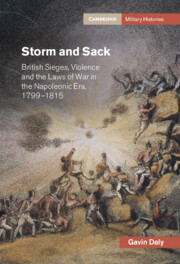Book contents
- Storm and Sack
- Cambridge Military Histories
- Storm and Sack
- Copyright page
- Dedication
- Contents
- Acknowledgements
- Introduction
- 1 Sieges in the Long Eighteenth Century
- 2 Surrender
- 3 Storm
- 4 Garrisons: The Fate of Enemy Soldiers
- 5 On Wellington’s Watch
- 6 Plunder
- 7 Atrocities against Civilians
- Conclusion
- Bibliography
- Index
7 - Atrocities against Civilians
Published online by Cambridge University Press: 29 September 2022
- Storm and Sack
- Cambridge Military Histories
- Storm and Sack
- Copyright page
- Dedication
- Contents
- Acknowledgements
- Introduction
- 1 Sieges in the Long Eighteenth Century
- 2 Surrender
- 3 Storm
- 4 Garrisons: The Fate of Enemy Soldiers
- 5 On Wellington’s Watch
- 6 Plunder
- 7 Atrocities against Civilians
- Conclusion
- Bibliography
- Index
Summary
This chapter investigates British sack atrocities to civilians during the Napoleonic era. It analyses how British soldiers represented this violence in their memoirs, especially through the lens of sensationalist gothic horror; and the challenges of estimating the scale of atrocities. It adopts a multi-contextual and multi-causal framework for understanding these atrocities, from situational rage and the brutalising experiences of war to the cultural and political contexts in which sack violence could operate. Whilst most British soldiers participated in the plundering of stormed towns, the murder and rape of civilians during sacks was perpetrated by only a minority. Across soldiers’ writings, we find horror, shame, and moral outrage at such acts; empathy towards the suffering civilian; and a moral duty to bear witness. And despite lamenting the inevitability of such atrocities, this did not prevent individuals, especially officers, from intervening to protect civilians, especially women, acts framed by chivalric and humanitarian ideals.
- Type
- Chapter
- Information
- Storm and SackBritish Sieges, Violence and the Laws of War in the Napoleonic Era, 1799–1815, pp. 227 - 268Publisher: Cambridge University PressPrint publication year: 2022

